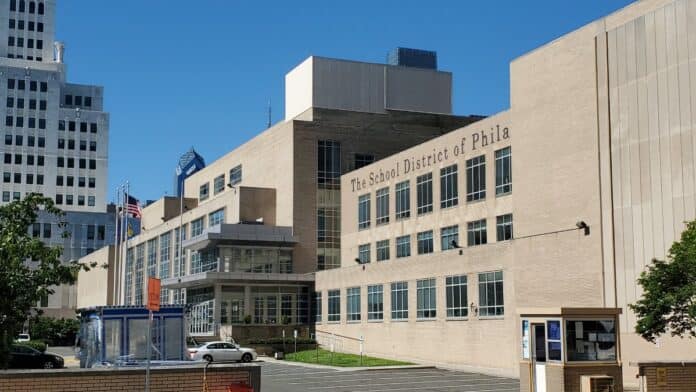Philadelphia’s public schools are improving, but there’s still much work to do.
Superintendent Tony Watlington, Sr. gave his second State of the Schools address at the School of the Future in West Philadelphia, where he shared some positive updates.
More students in grades three through eight are doing well in reading and math, fewer students are dropping out, and enrollment is rising for the first time in ten years.
These are good signs, but challenges like funding gaps and student needs remain.
The biggest improvement is in student performance.
Reading scores for third- through eighth-graders increased by 6.6%, while math scores rose by 5.5%.
More students are also graduating.
The four-year graduation rate improved by 6.3%, and 1,400 fewer students dropped out.
In addition, career and technical education programs are growing, with 13.6% more students passing their certification exams.
These programs help students get real skills in HVAC and automotive repair, preparing them for jobs after high school.
Another important change is that more families are choosing public schools again.
Enrollment increased by 1,841 students, the first rise in a decade, suggesting that people are gaining confidence in the district.
Even with these improvements, funding remains a major issue.
For years, Philadelphia’s schools have been underfunded.
A 2023 court ruling confirmed that Pennsylvania wasn’t distributing money fairly to schools.
In response, Governor Josh Shapiro and state lawmakers approved over $1 billion in new funding for 2024.
While this helps, many wonder if it’s enough to fully meet student needs, especially in a large urban district like Philadelphia.
At the same time, there are bigger concerns at the national level.
A recent report shows that reading scores for fourth- and eighth-graders are at their lowest point in 30 years.
This problem started before the pandemic, but school closures made it worse.
Some experts believe waiting until fourth grade to assess reading skills is too late.
Many students who struggle by that age already need serious intervention.
Pennsylvania’s school system faces unique challenges.
While public school enrollment is declining, staffing levels are still growing.
Currently, Pennsylvania has about 1.5 million K-12 students, down from 1.8 million in 2000.
Anyhow, despite having fewer students, the state has added 24,000 school employees, including a 44% increase in administrators and other non-teaching staff.
Education spending is also rising.
Pennsylvania will spend $16.8 billion on K-12 schools in 2024-25, which means an average of $21,985 per student—one of the highest rates in the country.
Even so, some districts raise local taxes while holding onto large amounts of unspent money.
Right now, Pennsylvania’s school districts have about $6.8 billion in reserve funds, which has led to debates about whether schools are managing their budgets efficiently.
Even though overall enrollment is declining, certain student populations are growing.
The number of English learners in Pennsylvania schools has increased by 22% since 2020, reaching nearly 90,000 students.
In Philadelphia, over 25,000 students speak 167 different languages.
The number of special education students has also grown, reaching 360,000—more than four times what it was twenty years ago.
Schools are struggling to keep up with the demand for services.
Another big issue is teacher pensions.
Pennsylvania ranks 11th in the nation for teacher pay, with the median full-time salary at $76,718 for 2023-24.
Nonetheless, schools are spending more and more money on pensions.
In total, Pennsylvania’s public schools spent $9.5 billion on employee benefits last year.
Since 2011, retirement contributions have increased by 367%.
The problem is that many of these payments are going toward past pension debt rather than funding current teachers’ retirements.
Some experts believe that restructuring the system could allow teachers to get raises without increasing costs.
Yet, Pennsylvania keeps increasing school funding.
The state now spends nearly $22,000 per student, and the 2024-25 budget added another $1.3 billion for education.
But not all of this money is going directly to students.
There are districts receiving extra funding for students who have left to attend cyber charter schools.
In fact, $34 million was cut from cyber charters, while $100 million was given to districts based on the number of students who transferred out, meaning some districts are being paid for students they no longer educate.
Schools also received billions in federal pandemic relief funds.
Since 2019, Pennsylvania public schools have received over $6.7 billion in COVID-related funding.
Although, according to a Harvard University report, this money didn’t close learning gaps as expected.
Some lawmakers are now pushing for policies that would let parents use tax credits for tutoring or private school tuition to help students catch up.
Philadelphia’s schools are improving, and that’s a good sign.
More students are succeeding in school, graduation rates are up, and enrollment is growing.
But major challenges remain.
Funding gaps, a rising number of English learners and special education students, and increasing pension costs make it difficult to sustain progress.
Superintendent Watlington has committed to keeping the district moving forward.
However, real, lasting improvement will depend on smart spending, continued investment, and if resources go directly to students.
The signs are encouraging for now, but the district’s long-term success will depend on how well it handles these challenges in the years ahead.





